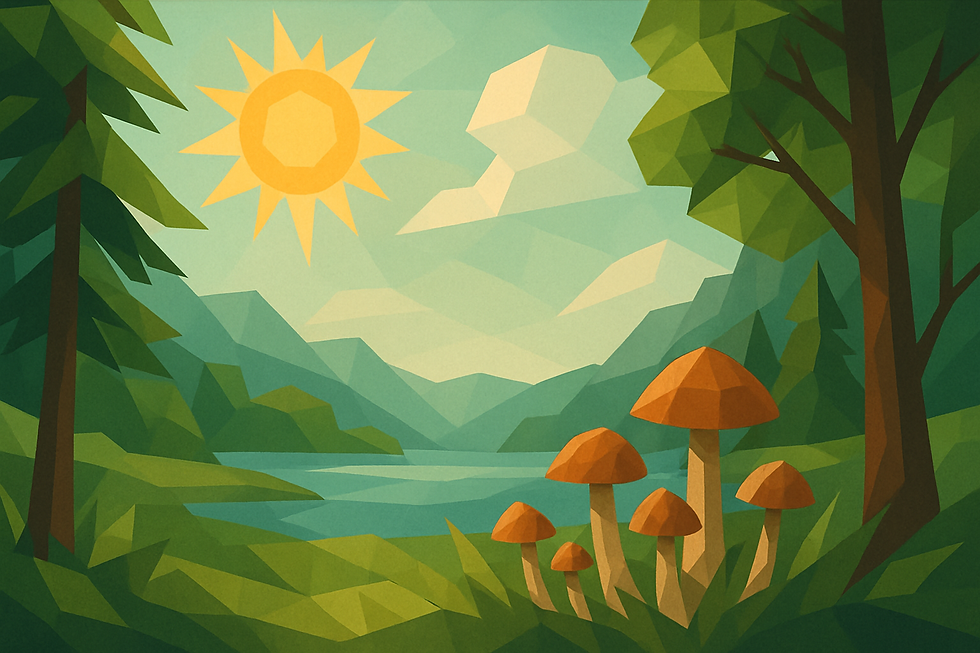Frequencies & Fungi: How Sound Shapes Your Mushroom Journey
- Edward Hawthorne

- Aug 13
- 2 min read

Introduction
Here’s a wild thought: what if the music you listen to actually shapes the mushrooms you consume?
At first glance, it sounds like the kind of thing a guy named Moonbeam would say at a forest rave. But science is catching up to something ancient wisdom has hinted at for centuries: sound affects biology. Not just in humans, but in plants, bacteria, and yes—fungi.
At Mammoth Mushrooms, we grow our mushrooms to the analog hum of vinyl records. Artists like Pink Floyd fill our grow rooms with layered frequencies and intention. Is it necessary? Maybe not. But does it matter? Absolutely.
1. The Science of Sonic Agriculture
Let’s start with some hard data. Studies have shown that sound waves can influence plant growth, seed germination, and even fungal morphology. One 2016 study found that exposure to certain frequencies increased yield and growth rates in fungi like Ganoderma lucidum.
Another study published by the marginalian suggested that sound vibrations affected mycelial density and fruiting patterns. The mechanism? Likely the way sound waves interact with cellular water and membrane structures, creating subtle changes in metabolism and gene expression.
Sound is vibration. Mushrooms respond to vibration. Boom.
2. Why Pink Floyd?
We’re not saying Roger Waters is a mycologist, but there’s something about ambient, spacious, psychedelic music that seems to resonate with mushrooms (and humans) on a deeper level. Long, sustained frequencies. Emotional arcs. Sonic storytelling.
Music like this may help create a more coherent energetic environment in the grow space—and if nothing else, it helps us grow with more joy and presence. Whether you're a farmer or a fungus, vibe matters.
3. Intention, Ritual, and Old Wisdom
Across Indigenous cultures, plants and fungi are often cultivated or harvested with song. Sound is a way of communicating with the organism, of honoring the reciprocal relationship. This isn't just romantic woo—it's a worldview where the grower is part of the medicine.
We’re inspired by this philosophy. From the substrate (see: Week 19 - Nutrient-Rich Substrates) to the soundscape, every part of our process is infused with intention.
4. How This Affects Your Experience
So... can you feel the music when you take a mushroom grown to the soundtrack of Dark Side of the Moon? Maybe.
While we can’t prove a direct link between listening environment and subjective effects, many of our customers describe a smoother, more connected, even more musical experience with our products.
And let’s not forget—your own set and setting matter, too. Choosing the right music to accompany your journey (micro or macro) is part of the art. Curious? Check out Week 11 - Microdosing for Recreation for tips on integrating music into intentional experiences.
Conclusion: Sound Is Not Just Vibe—It’s Structure
At the end of the day, mushrooms are more than molecules. They’re organisms, shaped by their environment, their inputs, and yes—their soundtrack.
We grow our fungi like we live our lives: tuned in, turned up, and dialed into the frequency of intention. Because when you grow with love, music, and soil that smells like the earth, you get a mushroom that does more than deliver psilocybin. It delivers presence.
So the next time you take a dose, ask yourself: what are you listening to? It might just be shaping you back.



Comments